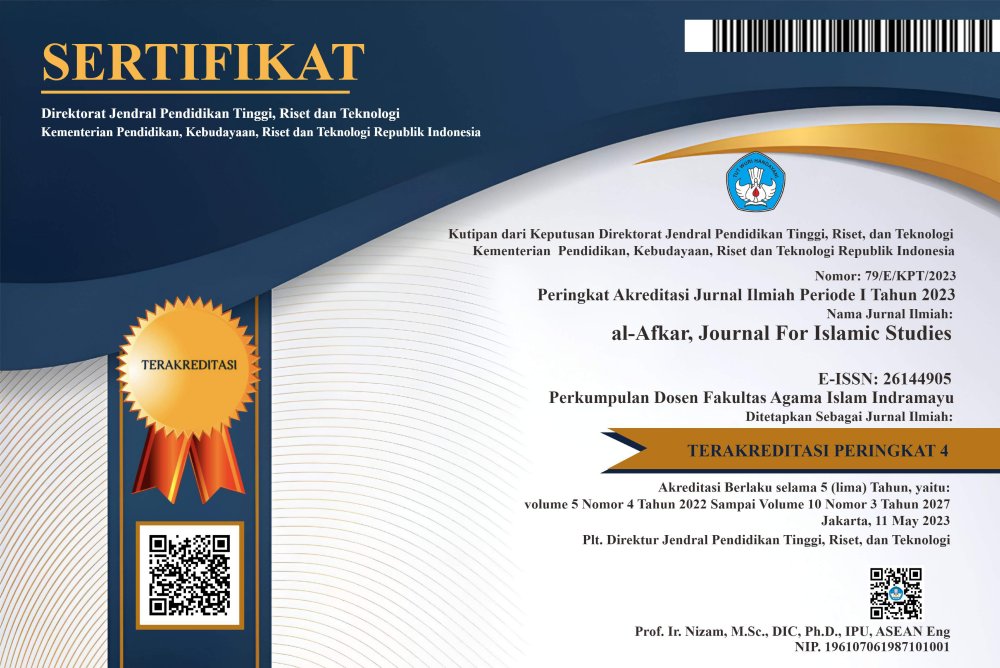Learning and Learning Conditions and Bloom Taxonomy and Islamic Education
DOI:
https://doi.org/10.31943/afkarjournal.v8i1.1784Keywords:
Learning Conditions, Bloom's Taxonomy, Islamic EducationAbstract
This research discusses learning and learning conditions as well as Bloom's Taxonomy and Islamic Education. The type of research in this article is qualitative descriptive research. Apart from that, this research is of a library nature (library research). The results of this research show that supportive learning conditions, combined with Bloom's Taxonomy framework, enable a more effective and comprehensive Islamic education process. By paying attention to learning conditions in accordance with the needs of the cognitive, affective and psychomotor domains, Islamic education can form individuals who not only have good religious knowledge but also have noble morals and skills that are able to practice religious teachings in everyday life.
Downloads
References
Dimas Ramdhan, Nazwah Fatimah, Syarifah, & Mahwiyah. (2023). Students in Islamic Education. Amandemen: Journal of Learning, Teaching and Educational Studies, 1(1), 22–28. https://doi.org/10.61166/amd.v1i1.4
Fuad, A. X. (2015). TAKSONOMI TRANSENDEN (PARADIGMA BARU TUJUAN PENDIDIKAN ISLAM). 6.
Hanafy, M. S. (2014). Konsep Belajar Dan Pembelajaran. Lentera Pendidikan : Jurnal Ilmu Tarbiyah Dan Keguruan, 17(1), 66–79. https://doi.org/10.24252/lp.2014v17n1a5
Hasan Baharun, K. S. (2018). Penilaian Berbasis Kelas Berorientasi HOTS Berdasarkan Taksonomi Bloom Pada Pembelajaran PAI. HIKMAH: Jurnal Pendidikan Islam, 7(2), 195.
Husnul Rita Binti Aris, Saedah Binti Siraj and Zaharah Hussin (2024) “Need Analysis Toward Development of Áqliyyah Nafsiyyah Taxonomy for Islamic Education Learning at Secondary Level”, al-Afkar, Journal For Islamic Studies, 7(3), pp. 199–215. doi: 10.31943/afkarjournal.v7i3.1261.
Ibnu Rusydi. (2023). The Urgency of Educational Media in Learning Islamic Religious Education. Al-Fadlan: Journal of Islamic Education and Teaching, 1(1), 18–23. https://doi.org/10.61166/fadlan.v1i1.4
Irmawati and Khozin (2024) “Analysis of Cognitive Revised Bloom’s Taxonomy in the PAI RPP Document at Sinarmekar Elementary School, Sukabumi Regency”, al-Afkar, Journal For Islamic Studies, 7(4), pp. 699–710. doi: 10.31943/afkarjournal.v7i4.1127.
Mahmudah, K. N. L., & Suyadi. (2017). Akal Bertingkat Ibnu Sina dan Taksonomi Bloom dalam Pendidikan Islam Perspektif Neurosains. Edukasia Islamika, 2(2), 172–190.
Moch. Salman Alfarizi, & Khozin. (2024). Holistic Curriculum Development in Islamic Education Institutions in Vocational Schools. LECTURES: Journal of Islamic and Education Studies, 3(1), 19–26. https://doi.org/10.58355/lectures.v3i1.79
Pane, A., & Darwis Dasopang, M. (2017). Belajar Dan Pembelajaran. FITRAH: Jurnal Kajian Ilmu-Ilmu Keislaman, 3(2), 333–352. https://doi.org/10.24952/fitrah.v3i2.945
M. Riad, & Iskandar Mirza. (2025). Tafsir Tarbawi Concept as Inspiration in the Islamic Education Curriculum. Kasyafa: Jurnal Pendidikan Agama Islam, 2(1), 72–81. https://doi.org/10.61166/kasyafa.v2i1.66
Wahab, G., & Rosnawati. (2021). Teori-teori belajar dan pembelajaran. In Paper Knowledge . Toward a Media History of Documents (Vol. 3, Issue April). http://repository.uindatokarama.ac.id/id/eprint/1405/1/TEORI-TEORI BELAJAR DAN PEMBELAJARAN.pdf
Wildani Firdaus, & Khozin. (2024). Cognitive Revised Bloom’s Taxonomy Analysis in RPP PAI Documents in Senior High Schools (SMA). Beginner: Journal of Teaching and Education Management, 2(1), 51–60. https://doi.org/10.61166/bgn.v2i1.44
Downloads
Published
How to Cite
Issue
Section
License
Copyright (c) 2025 La Ode Muhamad Risal, Amiruddin, Azlin, Saprin

This work is licensed under a Creative Commons Attribution 4.0 International License.



















